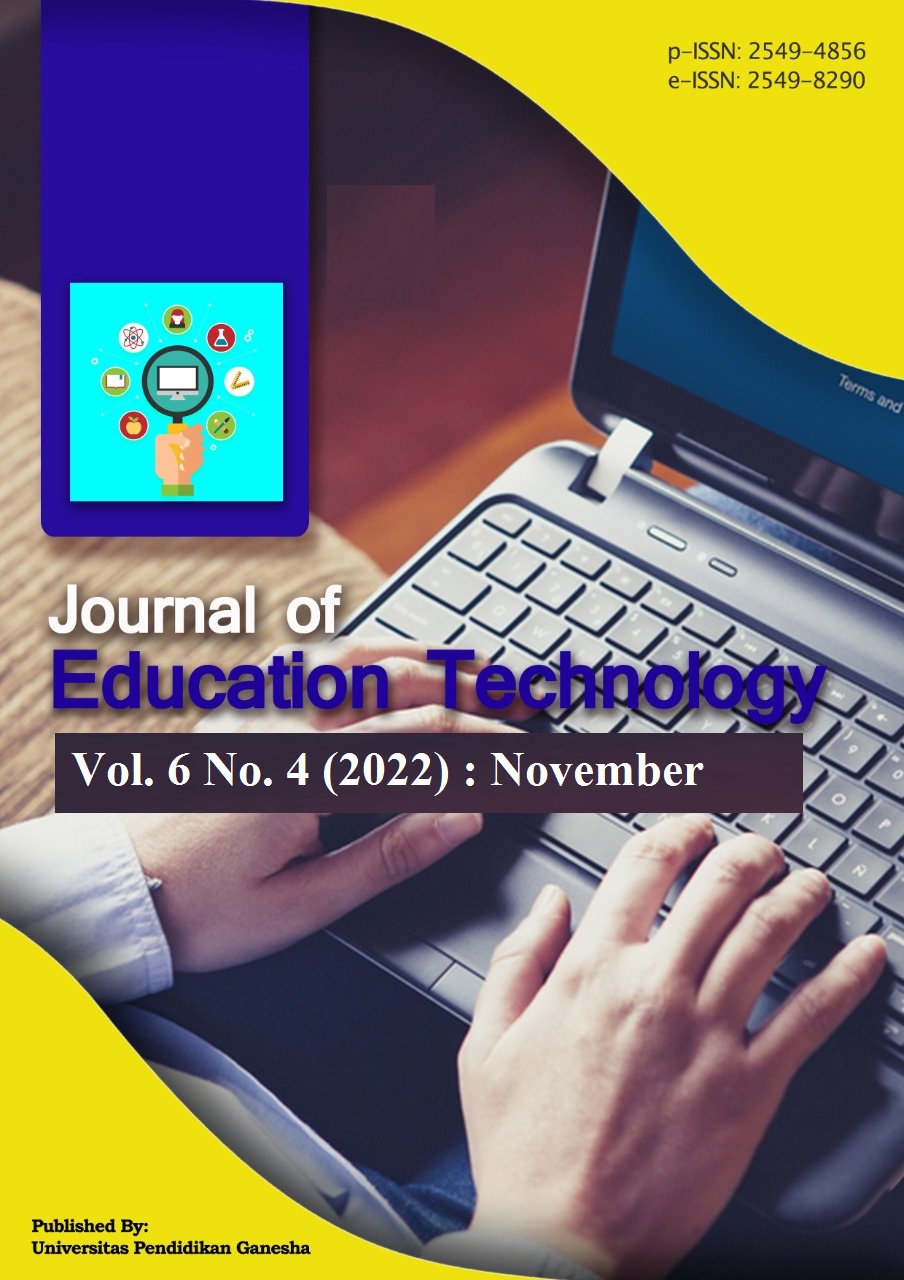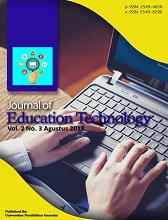Students’ Conceptual Understanding and Self-Directed Learning on Blended Learning
DOI:
https://doi.org/10.23887/jet.v6i4.49229Kata Kunci:
Conceptual understanding, Self-directed learning, Blended learningAbstrak
Learning physics requires understanding the concept so that students can analyze the relationship between concepts to explain a natural phenomenon. However, students need clarification and help to understand and analyze physics concepts. So to train to understand, students need self-directed learning. This study aims to analyze students' conceptual understanding, learning independence, and the effect of student learning independence on students' conceptual understanding of straight motion in blended learning. The sample in this study was 22 students of class X. The method in this study was a pre-experimental design with a one-group pretest-posttest group design. The instrument used in data collection is a test. Data were analyzed using the non-parametric Wilcoxon test and the one-sample T-test. The study results show that blended learning can significantly improve students' conceptual comprehension abilities and learning independence in straight-motion material. It is because students can learn independently during the learning process, so they are more active, creative, and independent in understanding a concept. Learning with blended learning influences understanding concepts, and understanding concepts affects students' self-directed learning.
Referensi
Affriyenni, Y., Swalaganata, G., Kurniawan, B. R., & Taqwa, M. R. A. (2021). Development of Android-based application: An effort to enhance students’ conceptual understanding in fundamental physics. AIP Conference Proceedings, 2330. https://doi.org/10.1063/5.0043428.
Alsalhi, N. R. (2020). The effects of the use of the know-want-learn strategy (KWL) on fourth grade students’ achievement in science at primary stage and their attitudes towards it. Eurasia Journal of Mathematics, Science and Technology Education, 16(4). https://doi.org/10.29333/ejmste/115165.
Ardianti, S., Sulisworo, D., Pramudya, Y., & Raharjo, W. (2020). The impact of the use of STEM education approach on the blended learning to improve student’s critical thinking skills. Universal Journal of Educational Research, 8(3 B). https://doi.org/10.13189/ujer.2020.081503.
Arista, F. S., & Kuswanto, H. (2018). Virtual physics laboratory application based on the android smartphone to improve learning independence and conceptual understanding. International Journal of Instruction, 11(1), 1–16. https://doi.org/10.12973/iji.2018.1111a.
Aulia, L. N., Susilo, S., & Subali, B. (2019). Upaya peningkatan kemandirian belajar siswa dengan model problem-based learning berbantuan media Edmodo. Jurnal Inovasi Pendidikan IPA, 5(1). https://doi.org/10.21831/jipi.v5i1.18707.
Bazelais, P., & Doleck, T. (2018). Investigating the impact of blended learning on academic performance in a first semester college physics course. Journal of Computers in Education, 5(1). https://doi.org/10.1007/s40692-018-0099-8.
Bloom, B. S., Engelhart, M. D., & Hill, H. H. (1956). Taxonomy of Educational Objectives. The Classification of Educational Goals, Handbook I: Cognitive Domain. David McKay Company. In Inc, New York.
Bouchée, T., de Putter - Smits, L., Thurlings, M., & Pepin, B. (2021). Towards a better understanding of conceptual difficulties in introductory quantum physics courses. In Studies in Science Education. https://doi.org/10.1080/03057267.2021.1963579.
Bukifan, D., & Yuliati, L. (2021). Conceptual understanding of physics within argument-driven inquiry learning for STEM education: Case study. AIP Conference Proceedings, 2330. https://doi.org/10.1063/5.0043638.
Cahyana, U., Supatmi, S., Erdawati, & Rahmawati, Y. (2019). The influence of web-based learning and learning independence toward student’s scientific literacy in chemistry course. International Journal of Instruction, 12(4). https://doi.org/10.29333/iji.2019.12442a.
Dewantara, D., Misbah, M., & Wati, M. (2020). The implementation of blended learning in analog electronic learning. Journal of Physics: Conference Series, 1422(1). https://doi.org/10.1088/1742-6596/1422/1/012002.
Eveline, E., Jumadi, Wilujeng, I., & Kuswanto, H. (2019). The Effect of Scaffolding Approach Assisted by PhET Simulation on Students’ Conceptual Understanding and Students’ Learning Independence in Physics. Journal of Physics: Conference Series, 1233(1). https://doi.org/10.1088/1742-6596/1233/1/012036.
Fadllan, A., Prawira, W. Y., Arsini, & Hartono. (2019). Analysis of students’ misconceptions on mechanics using three-tier diagnostic test and clinical interview. Journal of Physics: Conference Series, 1170(1). https://doi.org/10.1088/1742-6596/1170/1/012027.
Gaol, F. L., & Hutagalung, F. (2020). The trends of blended learning in South East Asia. In Education and Information Technologies (Vol 25, Number 2). https://doi.org/10.1007/s10639-020-10140-4.
Herayanti, L., Widodo, W., Susantini, E., & Gunawan, G. (2020). The effectiveness of blended learning model based on inquiry collaborative tutorial toward students’ problem-solving skills in physics. Journal for the Education of Gifted Young Scientists, 8(3). https://doi.org/10.17478/JEGYS.675819.
Jani, J., Muszali, R., Nathan, S., & Abdullah, M. S. (2018). Blended Learning Approach Using Frog Vle Platform Towards Students’ Achievement in Teaching Games for Understanding. J Fundam Appl Sci, 10(5S). https://doi.org/10.4314/jfas.v10i5s.94.
Kesuma, G. C., Diani, R., Hasanah, N., & Fujiani, D. (2020). Blended Learning Model: Can It Reduce Students’ Misconception in Physics? Journal of Physics: Conference Series, 1467(1). https://doi.org/10.1088/1742-6596/1467/1/012044.
Krasnova, L. A., & Shurygin, V. Y. (2020). Blended learning of physics in the context of the professional development of teachers. International Journal of Technology Enhanced Learning, 12(1). https://doi.org/10.1504/IJTEL.2020.103814.
Maduretno, T. W. (2017). Tingkat Kemandirian Mahasiswa Pendidikan Sains Pada Konsep Diagram Gaya. Jurnal Pendidikan Fisika dan Keilmuan (JPFK), 3(2). https://doi.org/10.25273/jpfk.v3i2.1348.
Marisda, D. H., & Ma’Ruf, M. (2021). Situation analysis of mathematical physics learning with online learning during the COVID-19 pandemic. Journal of Physics: Conference Series, 1806(1). https://doi.org/10.1088/1742-6596/1806/1/012034.
Maskur, R., Latifah, S., Pricilia, A., Walid, A., & Ravanis, K. (2019). The 7E learning cycle approach to understand thermal phenomena. Jurnal Pendidikan IPA Indonesia, 8(4). https://doi.org/10.15294/jpii.v8i4.20425.
Maulida, D. R., Suparwoto, Pramudya, Y., & Sulsworo, D. (2020). Embedding the guided inquiry on blended learning to enhance conceptual understanding. International Journal of Scientific and Technology Research, 9(1).
Morris, T. H. (2019). Self-directed learning: A fundamental competence in a rapidly changing world. International Review of Education, 65(4). https://doi.org/10.1007/s11159-019-09793-2.
Oktavianti, E., Handayanto, S. K., Wartono, & Saniso, E. (2018). Students’ scientific explanation in blended physics learning with E-scaffolding. Jurnal Pendidikan IPA Indonesia, 7(2). https://doi.org/10.15294/jpii.v7i2.14232.
Pujayanto, P., Budiharti, R., Adhitama, E., Nuraini, N. R. A., & Putri, H. V. (2018). The development of a web-based assessment system to identify students’ misconception automatically on linear kinematics with a four-tier instrument test. Physics Education, 53(4). https://doi.org/10.1088/1361-6552/aac695.
Rahmat, I. (2020). Implementasi Andragogi Platform E-learning pada Blended Learning di Universitas Negeri Padang. Journal of Education Technology, 4(2), 133. https://doi.org/10.23887/jet.v4i2.24817.
Sivakumar, P., & Selvakumar, S. (2019). Blended learning package: It’s effectiveness on students’ performance and retention in higher secondary physics course. International Journal of Scientific and Technology Research, 8(10).
Suana, W., Maharta, N., Nyeneng, I. D. P., & Wahyuni, S. (2017). Design and implementation of Schoology-based blended learning media for basic Physics I course. Jurnal Pendidikan IPA Indonesia, 6(1). https://doi.org/10.15294/jpii.v6i1.8648.
Suana, W., Ningsih, W. S. A., Maharta, N., & Putri, N. M. A. A. (2020). The effect of blended learning setting on students’ critical thinking skills in physics. Journal of Physics: Conference Series, 1572(1). https://doi.org/10.1088/1742-6596/1572/1/012073.
Suma, K., Suwindra, I. N. ., & Sujanem, R. (2020). The Effectiveness of Blended Learning in Increasing Prospective Physics Teacher Students’ Learning Motivation and Problem-Solving Ability. JPI (Jurnal Pendidikan Indonesia), 9(3), 436–445. https://doi.org/10.23887/jpi-undiksha.v9i3.21947.
Wells, J., Henderson, R., Traxler, A., Miller, P., & Stewart, J. (2020). Exploring the structure of misconceptions in the force and motion conceptual evaluation with modified module analysis. Physical Review Physics Education Research, 16(1). https://doi.org/10.1103/PHYSREVPHYSEDUCRES.16.010121.
Wintarti, A., Masriyah, Ekawati, R., & Fiangga, S. (2019). Blended Learning as a Learning Strategy in the Disruptive Era. Journal of Physics: Conference Series, 1387(1). https://doi.org/10.1088/1742-6596/1387/1/012127.
Wisanti, Ambawati, R., Putri, E. K., Rahayu, D. A., & Khaleyla, F. (2021). Science online learning during the covid-19 pandemic: Difficulties and challenges. Journal of Physics: Conference Series, 1747(1). https://doi.org/10.1088/1742-6596/1747/1/012007.
Zain, A. R., & Jumadi. (2018). Effectiveness of guided inquiry based on blended learning in physics instruction to improve critical thinking skills of the senior high school student. Journal of Physics: Conference Series, 1097(1). https://doi.org/10.1088/1742-6596/1097/1/012015.
Unduhan
Diterbitkan
Cara Mengutip
Terbitan
Bagian
Lisensi
Hak Cipta (c) 2022 Ria Riski Novita

Artikel ini berlisensiCreative Commons Attribution-ShareAlike 4.0 International License.
Authors who publish with the Journal of Education Technology agree to the following terms:
- Authors retain copyright and grant the journal the right of first publication with the work simultaneously licensed under a Creative Commons Attribution License (CC BY-SA 4.0) that allows others to share the work with an acknowledgment of the work's authorship and initial publication in this journal.
- Authors are able to enter into separate, additional contractual arrangements for the non-exclusive distribution of the journal's published version of the work (e.g., post it to an institutional repository or publish it in a book), with an acknowledgment of its initial publication in this journal.
- Authors are permitted and encouraged to post their work online (e.g., in institutional repositories or on their website) prior to and during the submission process, as it can lead to productive exchanges, as well as earlier and greater citation of published work. (See The Effect of Open Access)


















